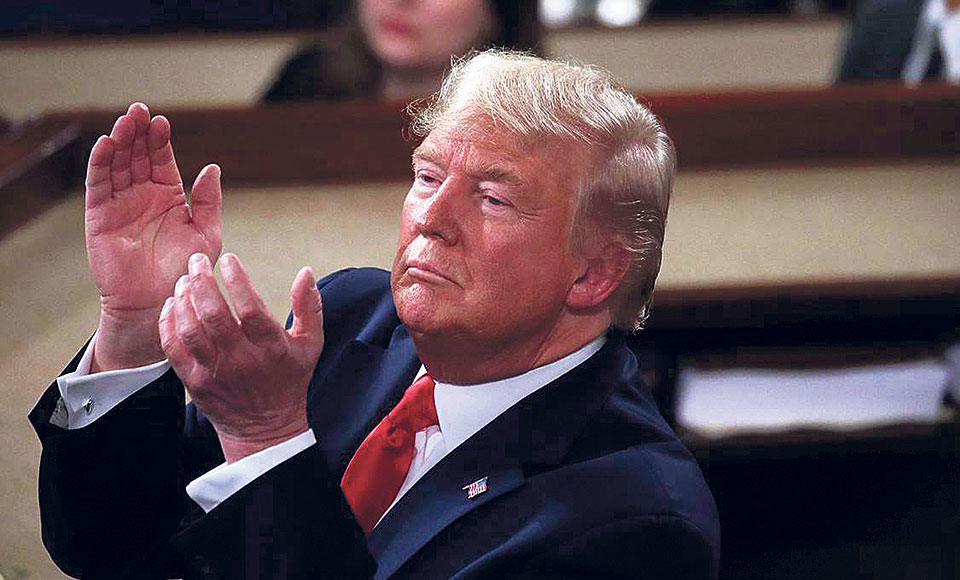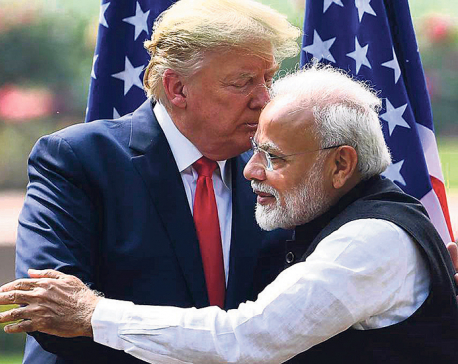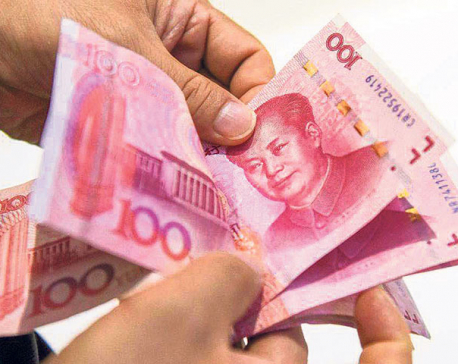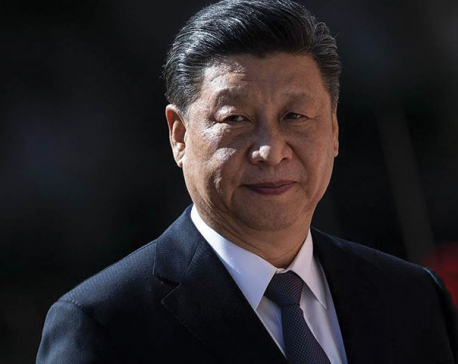
OR


Nina L Khrushcheva
Nina L Khrushcheva is Professor of International Affairs at The New School. Her latest book (with Jeffrey Tayler) is “In Putin’s Footsteps: Searching for the Soul of an Empire Across Russia’s Eleven Time Zones”news@myrepublica.com
Stalin prosecuted his perceived adversaries as “enemies of the people.” Trump has used the same rhetoric, calling his media critics the “enemy of the people”
NEW YORK – “In just three short years,” US President Donald Trump declared in his recent State of the Union (SOTU) address, “we have shattered the mentality of American decline and we have rejected the downsizing of America’s destiny.” This baseless pronouncement—more propaganda than reality—recalled Joseph Stalin’s 1935 proclamation that “Life has improved, comrades; life has become more joyous.”
When Stalin touted “the radical improvement in the material welfare of the workers” brought about by the Soviet regime, production statistics were lagging; famine had ravaged populations, especially in Ukraine; and the Great Purge—a brutal campaign of political repression—was already in sight. Likewise, as Trump praises his administration for supposedly restoring America’s greatness, US allies and friends are scrambling to reduce their dependence on the US, which has become both a threat to global stability and an international laughing stock.
Trump’s declarations about the economy are similarly misleading. Yes, GDP growth remains relatively strong, and stock prices have reached record highs. But, as Michigan Governor Gretchen Whitmer pointed out after the SOTU, “millions of people struggle to get by, or don’t have enough money at the end of the month after paying for transportation, student loans, or prescription drugs.” The “blue-collar boom” that Trump touted has left out a significant share of blue-collar workers.
I am not claiming that Trump is the new Stalin, let alone equating today’s US to the Soviet Union of the 1930s. But I know propaganda when I hear it, and Trump’s words are nothing less than the genuine article. I also know how effective good propaganda can be in terms of creating space for dictatorial behavior—and how vulnerable even the strongest democracy can be to totalitarianism.
Of course, propaganda involves more than just words. Authoritarian rulers use other tools to cultivate an aura of greatness. Architecture is one such tool. From the Egyptian pharaohs to the Roman emperors to contemporary dictators like North Korea’s Kim Jong-un, authoritarian leaders have often used (or abused) architecture to manipulate public perceptions, by creating grandiose public spaces that reflect their splendid image of themselves.
Leni Riefenstahl’s controversial 1938 cinematic masterpiece Olympia, based on the 1936 Berlin Summer Olympics, was shot in a manner intended to emphasize the masculine, domineering air of the stadium—and, by extension, the Nazi regime. Then there was Albert Speer’s early 1930s makeover of Berlin, which channeled the regime’s totalitarian ambition into uniformly imposing and brutal neoclassical architecture.
Stalin replicated Hitler’s imperial model with his own architectural “classicism”: high rises with domes, spires, and other trimmings meant to denote power. Stalin also took inspiration from New York City’s Manhattan Municipal Building, which signified the Empire State’s grandeur in the 1910s.
Now, the Trump administration is circulating a draft executive order called “Making Federal Buildings Beautiful Again,” which would have architects adhere to “classical” structures, inspired by Greek and Roman tradition. The order underscores the symbolic value of buildings, and explicitly opposes the 1962 “Guiding Principles of Federal Architecture”—supported by President John F. Kennedy—which called for design to flow from the architectural profession to the government.
Perhaps this should not be surprising. Long before he became president, Trump was using architecture to assert his power and privilege. The gaudy gilded constructions that characterize his numerous Trump buildings, for example, have much in common with the lavish rococo tastes embraced by contemporary autocrats like China’s Xi Jinping, Russia’s Vladimir Putin, and Turkey’s Recep Tayyip Erdogan.
These leaders have also engaged in another classic form of authoritarian power projection: military parades, which are a tried-and-true method for authoritarian figures seeking to impress supporters and opponents alike. In 2017, Trump could not contain his excitement at a Bastille Day military parade in Paris—there, a ceremony rather than muscle-flexing—held next to the Arc de Triomphe (incidentally, one of Speer’s inspirations for Nazi Berlin). Two years later, Trump held his own, dizzyingly expensive military parade.
It may be tempting to dismiss such performances as distractions. But they directly enable a predilection for dangerous or reckless behaviors, including the rejection of all checks on executive power—crucial to a functioning democracy.
Trump’s inability to accept criticism is particularly concerning. Stalin prosecuted his perceived adversaries as “enemies of the people,” imprisoning or killing thousands for disloyalty. Of course, Trump may not be able to get away with quite that level of repression, but he has used the same rhetoric, calling his media critics the “enemy of the people.”
Moreover, immediately after his acquittal by the Republican-controlled Senate in a sham impeachment trial in which no witnesses were called, Trump fired those who had testified in the House of Representatives about his efforts to coerce Ukrainian President Volodymyr Zelensky to investigate a political rival. It was a sterling example of the retribution on which dictatorships depend.
Indeed, when impeachment witness Lt. Col. Alexander S. Vindman was fired, security officers marched his twin brother, Lt. Col. Yevgeny Vindman, a lawyer on the National Security Council staff, out of the White House alongside him. It was pure petty vindictiveness. In the USSR in the 1930s, Yevgeny would have been dubbed a ChSVR (Member of an Enemy of the People Family) and sentenced to five years in a Siberian gulag.
This is how dictatorships begin. As the US prepares for its next presidential election in November, it is every citizen’s responsibility rationally to examine Trump’s dictatorial impulses, which reelection would only reinforce. It is not safe to assume that he won’t go too far, or that he is too much of a “mediocrity”—as Leon Trotsky called Stalin (an assessment with which many Bolsheviks agreed)—to transform his country.
Vladimir Lenin, himself a ruthless Bolshevik, wrote in 1922 that, “Stalin concentrated in his hands enormous power, which he won’t be able to use responsibly,” owing to traits like rudeness, intolerance, and capriciousness. Trump has all of them in spades. The more power he concentrates in his own hands, the dimmer the long-term outlook for American democracy becomes. His reelection could mean lights out.
Nina L. Khrushcheva is Professor of International Affairs at The New School. Her latest book (with Jeffrey Tayler) is “In Putin’s Footsteps: Searching for the Soul of an Empire Across Russia’s Eleven Time Zones”
© 2020 Project Syndicate
www.project-syndicate.org
You May Like This

Tale of Two Demagogues
PARIS – “America loves India,” declared US President Donald Trump on his recent visit to the Indian state of Gujarat,... Read More...

Trump’s “Currency Manipulation” Con
WASHINGTON, DC – Would you believe the following story if you heard it? Imagine a small, rural town with one... Read More...

China’s feet of clay
CAMBRIDGE – Chinese President Xi Jinping seems to be on a roll. He has sent a rocket to the dark... Read More...







Just In
- NRB to provide collateral-free loans to foreign employment seekers
- NEB to publish Grade 12 results next week
- Body handover begins; Relatives remain dissatisfied with insurance, compensation amount
- NC defers its plan to join Koshi govt
- NRB to review microfinance loan interest rate
- 134 dead in floods and landslides since onset of monsoon this year
- Mahakali Irrigation Project sees only 22 percent physical progress in 18 years
- Singapore now holds world's most powerful passport; Nepal stays at 98th











Leave A Comment